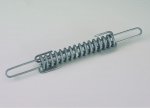I will approach this problem, only considering the dead weight of the fixture. In reality, there is a seismic calculation with an equivalent lateral force, that also governs the reaction loads on the anchors.
It is reasonable to assume shear is equally distributed among the anchors. Thus, assuming symmetric snubbers on the left, the shear in each anchor = weight/8. One reason why shear wouldn't be equally distributed, is if you had a load that applied a rotating moment to the fixture CW or CCW, as viewed from the front. This would happen if the contents of the fixture were either left-heavy or right-heavy.
Number the left/right fastener pairs 1 thru 4, from bottom to top. Call the tension in each fastener, T1 thru T4. Two fasteners have tension T1, and so forth, so you'll see a factor of 2 in front of T1 thru T4, when we use them. Call their vertical positions from the bottom, y1 thru y4.
The fixture will compress against its bottom edge. Call the total compression force C. We ultimately don't care what C is, but it may be an important placeholder for the algebra.
Force balance in the front-back direction:
C = 2*(T1 + T2 + T3 + T4)
Take moments about the bottom edge, so that C doesn't appear in the following equation. The center of mass of your fixture, is offset from the wall a distance d. The total moment about the bottom edge due to the fixture weight (W), is W*d.
W*d = 2*(T1*y1 + T2*y2+ T3*y3 + T4*y4)
The approximation with the tension calculation, is that the fixture is infinitely rigid, compared to the stiffness of the fasteners, and that the fasteners are linear-elastic in their response to tension. We're also neglecting rotation between the fixture and the snubbers. If we did consider the fixture fastener rotating within the snubbers, we'd have the same reasoning, but in two layers of calculations. This all means that stretch distance in each fastener is proportional to its y-value, for geometric consistency. With the linear elastic assumption, it also means the y-value is proportional to the the tension in the fastener. Define a constant of proportionality k, to relate tension to y-position. The value of k is not necessarily the spring constant of the fastener, don't let the name deceive you.
This generates the following equations:
T1 =k*y1
T2 =k*y2
T3 =k*y3
T4 =k*y4
Replace T1 thru T4 in the moment equation:
W*d = 2*k*(y1^2 + y2^2+ y3^2 + y4^2)
Solve for k:
k = (W*d)/(2*(y1^2 + y2^2+ y3^2 + y4^2))
Plug in your given information for W, d, and the y's. Get your value of k. Then multiply by the y-positions to get each tension. This gives the tension in each fastener.
![[IMG] [IMG]](https://forums.mikeholt.com/attachments/1584386347694-png.2551773/?hash=757a6d68aa7c2dca13f2017f39796994)
![[IMG] [IMG]](https://forums.mikeholt.com/attachments/1584386329181-png.2551772/?hash=757a6d68aa7c2dca13f2017f39796994)

